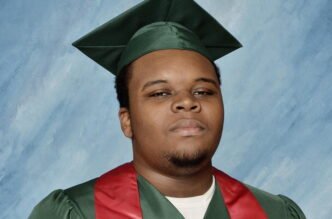Basic Information
| Full Name | Michael Orlandus Darrion Brown |
|---|---|
| Date of Birth | May 20, 1996 |
| Place of Residence | Ferguson, Missouri |
| Education | Normandy High School (alternative program graduate, May 2014) |
| Creative Moniker | Big’Mike (SoundCloud rap artist) |
| Date of Death | August 9, 2014 (aged 18) |
| Training Program | Enrolled in HVAC program at Vatterott College (August 11, 2014) |
| Net Worth | None publicly recorded |
Early Life and Education
Michael Brown was born on May 20, 1996, in Ferguson, Missouri, and spent his youth navigating the challenges of a community marked by economic hardship and social tension.
Raised by his single mother, Michael completed an alternative education program at Normandy High School, earning his diploma just days before his untimely death.
Known among peers for his gentle demeanor and quick smile, he balanced schoolwork with part-time jobs, demonstrating a strong desire to support his family’s financial needs.
Creative Aspirations: “Big’Mike” on SoundCloud
Beyond academics, Michael nurtured a passion for music.
Under the moniker Big’Mike, he recorded and uploaded rap tracks to SoundCloud, exploring themes of resilience, identity, and life in Ferguson.
Though his discography was small—fewer than ten tracks—his lyrics revealed a thoughtful young artist grappling with personal and community struggles.
Friends recall his dreams of one day performing on stage and using music to uplift others.
While no official streaming statistics exist, Michael’s page on SoundCloud remains active today, serving as a testament to his creative voice.
Aspiring musicians and activists alike have shared his tracks in tribute playlists, ensuring Big’Mike’s rhythm endures.
The Shooting and National Uproar
On August 9, 2014, Michael Brown was shot and killed by a Ferguson police officer, an event captured by multiple eyewitness accounts and cell-phone videos.
His death at age 18 ignited immediate protests in Ferguson, drawing national attention to issues of police use of force and systemic racial bias.
Within days, the hashtag #HandsUpDontShoot became a rallying cry across social media, and demonstrators gathered in cities from New York to Los Angeles.
In November 2014, a U.S. Department of Justice report concluded there was no prosecutable case against the officer, but the findings spotlighted a pattern of discrimination in Ferguson’s municipal court system.
These revelations deepened public scrutiny of policing practices and cemented Michael’s death as a key moment in contemporary civil-rights activism.
Legacy and the Birth of Black Lives Matter
Michael Brown’s shooting catalyzed the formation of the Black Lives Matter movement.
Co-founders Alicia Garza, Patrisse Cullors, and Opal Tometi identified Ferguson as the spark that transformed social-media advocacy into nationwide protests.
Since 2014, Black Lives Matter has organized campaigns addressing police reform, voter suppression, and economic justice, with chapters in over 40 U.S. cities.
Annual statistics illustrate enduring concern: between 2015 and 2023, over 1,200 people were killed by police in the United States each year, with Black Americans disproportionately affected.
Commemorative events in Ferguson and beyond continue to draw thousands, underscoring Michael’s unintended but profound impact on the national conversation about race and policing.
Commemorations and Recent Reflections
In August 2024, Ferguson marked the 10th anniversary of Michael’s death with a series of panel discussions, vigils, and community workshops exploring the shooting’s legacy.
A St. Louis Public Radio report detailed conversations on policy reform and community healing.
Likewise, national news outlets like Yahoo News published retrospectives analyzing progress and persistent challenges in criminal-justice reform.
| Event | Date | Focus |
|---|---|---|
| Ferguson Vigil | August 9, 2024 | Moment of silence and student reflections |
| Policy Panel | August 10, 2024 | Dialogue with local leaders on police accountability |
| Community Art Exhibit | August 11, 2024 | Murals and spoken-word performances inspired by Michael’s life |
Personal Reflections and Family Resilience
Michael’s mother and stepfather have since become advocates for youth mentorship and restorative-justice programs.
They established the Big’Mike Foundation in 2016 to provide scholarships and leadership training for at-risk teens in St. Louis County.
Through counseling services and creative workshops, the foundation channels Michael’s artistic spirit into positive community action.
Family members emphasize that Michael was more than a symbol—he was a son, a friend, and an artist with aspirations.
By balancing honor for his memory with forward-looking initiatives, they ensure his name continues to inspire dialogue, reform, and hope.
For a contrasting portrait of public influence through a very different journey, see the story of Lesly Brown Sajak,
whose path from modeling to photography in television offers another example of how individuals shape their legacies.
FAQ
Who was Michael Brown?
Michael Brown was an 18-year-old Ferguson resident whose 2014 shooting by a police officer sparked national protests and helped launch Black Lives Matter.
What was “Big’Mike” known for?
Under the stage name Big’Mike, he uploaded rap tracks to SoundCloud that explored personal and community challenges in Ferguson.
What legal outcomes followed his death?
A Department of Justice report in November 2014 found evidence of racial bias in Ferguson’s policing but did not bring criminal charges against the officer.
How is he commemorated today?
Ferguson holds annual vigils and policy panels; his family’s Big’Mike Foundation provides scholarships and mentorship to at-risk youth.
Where can I learn more about Lesly Brown Sajak?
Read about Lesly Brown Sajak’s career in photography and television at baronton.com/lesly-brown-sajak.







